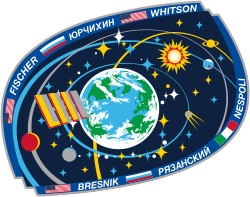Peggy Whitson
| Peggy Annette Whitson | |
 Peggy A. Whitson | |
| NASA-astronaut | |
|---|---|
| Född | 9 februari 1960 Mount Ayr, Iowa, |
| Tid i rymden | 675 dagar, 3 timmar, 48 minuter |
| Urvalsgrupp | Astronautgrupp 16 |
| Antal rymdpromenader | 10 st |
| Rymdpromenadtid | 60 timmar, 21 minuter |
| Uppdrag | STS-111 Expedition 5 STS-113 Sojuz TMA-11 Expedition 16 Sojuz MS-03/Sojuz MS-04 Expedition 50/51/52 Ax-2 |
| Uppdragsemblem | |
Peggy Annette Whitson, född 9 februari 1960 i Mount Ayr, Iowa, är en amerikansk astronaut. Hon blev uttagen i astronautgrupp 16 den 5 december 1996. Whitson är den kvinna som har tillbringat längst tid i rymden, hela 665 dagar, fördelad på tre olika uppdrag. Under sin tid i rymden gjorde hon tio rymdpromenader.
I oktober 2007 blev hon den första kvinnliga befälhavaren på den internationella rymdstationen ISS. Och i april 2017 blev hon den första kvinnan att föra befälet på rymdstationen en andra gång.
Asteroiden 15057 Whitson är uppkallad efter henne.[1]
Rymdfärder
- Juni - december 2002. Till ISS med STS-111, Expedition 5, hem med STS-113.
- Oktober 2007 - april 2008. Befälhavare för Expedition 16, till ISS med Sojuz TMA-11, hem med Sojuz TMA-11.
- November 2016 - september 2017. Tillsammans med fransmannen Thomas Pesquet, den ryske kosmonauten Oleg Novitskij sköts Whitson upp från rymdbasen Baikonur i Kazakstan 27 november, som deltagare i Expedition 50 och Expedition 51 på ISS.[2] Expedition 50 avslutades den 10 april 2017, Whitson stannade som planerat kvar på ISS som deltagare i Expedition 51. Expedition 51 avslutades 2 juni 2017. Då det fanns en plats ledig på Sojuz MS-04 beslutades det i april 2017 att Whitson även skulle överföras till Expedition 52, som avslutades den 3 september 2017, då Fjodor Jurtjichin, Jack D. Fischer och Whitson återvände till jorden med Sojuz MS-04.[3]
- Axiom Mission 2, privatfinansierad flygning till ISS.
Rymdfärdsstatistik
| Färd | Datum | Tid | EVA |
|---|---|---|---|
| STS-111, ISS-5, STS-113 | 5 juni - 7 december 2002 | 184 d, 22 t, 14 m | 4 t, 25 m |
| Sojuz TMA-11, ISS-16 | 10 oktober 2007 - 19 april 2008 | 191 d, 19 t, 7 m | 34 t, 49 m |
| Sojuz MS-03, ISS-50, ISS-51, ISS-52, Sojuz MS-03 | 17 november 2016 - 3 september 2017 | 289 d, 5 t, 1 m | 20 t, 35 m |
| Axiom Mission 2 | 21 maj - 31 maj 2023 | 9 d, 5 t, 26 m | 0 m |
| Totalt | 675 d, 3 t, 48 m | 60 t, 21 m | |
Referenser
- ^ ”Minor Planet Center 15057 Whitson” (på engelska). Minor Planet Center. https://www.minorplanetcenter.net/db_search/show_object?object_id=15057. Läst 1 november 2024.
- ^ Rymdstation fick ny besättning- SVT
- ^ Mars, Kelli (9 november 2015). ”Peggy A. Whitson (PH.D.) NASA Astronaut”. NASA. http://www.nasa.gov/astronauts/biographies/peggy-a-whitson/biography. Läst 5 januari 2019.
| |||||||||||
|
Media som används på denna webbplats
This patch commemorates the sixteenth expeditionary mission to the International Space Station (ISS). The design represents the conjunction of two unique astronomical events: a transit of the ISS across the surface of a full moon, and a nearly complete annular eclipse of the sun. The ISS is shown in its complete configuration, symbolizing the role of this expedition in preparing for the arrival and commissioning of international partner modules and components. The ISS transit across the moon highlights its role in developing the techniques and innovations critical to enable long-duration expeditions to the lunar surface and beyond.
The International Space Station (ISS) Expedition Five patch depicts the Station in its completed configuration and represents the vision of mankind's first step as a permanent human presence in space. The United States and Russian flags are joined together in a Roman numeral V to represent both the nationalities of the crew and the fifth crew to live aboard the ISS. Crew members’ names are shown in the border of this patch. This increment encompasses a new phase in growth for the Station, with three Shuttle crews delivering critical components and building blocks to the ISS. To signify the participation of each crew member, the Shuttle is docked to the Station beneath a constellation of 17 stars symbolizing all those visiting and living aboard Station during this increment.
* This is the crew patch for the STS-113 mission, which will be the eleventh American (11A) assembly flight to the International Space Station (ISS). The primary mission will be to take the Expedition Six crew to the ISS and return the Expedition Five crew to Earth. STS-113 will be the first flight in the assembly sequence to install a major component in addition to performing a crew exchange. The Port 1 Integrated Truss Assembly (P1) will be the first truss segment on the left side of the ISS. P1 will provide an additional three External Thermal Control System radiators, adding to the three radiators on the Starboard 1 (S1) Integrated Truss Assembly. The installation and outfitting of P1 will require three extravehicular activities (space walks) as well as coordination between the Shuttle Robotic Manipulator System and the Space Station Robotic Manipulator System. The patch depicts the Space Shuttle Endeavour docked to the ISS during the installation of the P1 truss with the gold astronaut symbol in the background.
- The seven stars at the top left center of the patch are the seven brightest stars in the constellation Orion. They represent the combined seven crew members (four Shuttle and three Expedition Six). The three stars to the right of the astronaut symbol represent the returning Expedition Five crew members. The Shuttle crew names are on the solar arrays of the P6 truss. The ISS Expedition crew names are in a chevron that also features the American and Russian flags. The Expedition 6 crew names are on top of the Expedition 5 crew names, since Expedition 6 goes up while Expedition 5 goes down. The Roman Numeral CXIII represents the mission number 113.
Official crew Patch of Expedition 50 on the International Space Station.
- The Expedition 50 patch encompasses the spirit of human exploration from previous missions to the moon to current exploration on the International Space Station (ISS). The red border symbolizes future human exploration of Mars – the Red Planet. Our home planet Earth is prominent in the patch to remind us that everything done on the mission is to help people on Earth – “Off the Earth, For the Earth.” The background colors of red, white, and blue represent the national colors of all six crew members – United States, Russia, and France. The six stars represent the families of all six crewmembers. Finally, the numeral 50 signifies the 50th Expedition to the ISS.
Official crew patch of Expedition 51 during their mission to the International Space.
- From as early as the 11th century, coats of arms have been used as emblems representing groups as small as families to as large as countries. The Expedition 51 patch is designed as a modernized international coat of arms, blending the traditional shield shape with our modernized symbol of achievement, the International Space Station. The background represents our home world and its inhabitants on the left, and outer space to the right. The bi-color International Space Station is the bridge between the two, symbolizing the benefits on Earth of space research, and at the same time our mission to explore deeper into space, on a path to further discovery and knowledge.
portrait astronaut peggy whitson
The Expedition 52 crew insignia
- Our planet is shown surrounded by an imaginary constellation shaped like a house, depicting the theme of the patch: “The Earth is our home.” It is our precious cradle, to be preserved for all future generations. The house of stars just touches the Moon, acknowledging the first steps we have already taken there, while Mars is not far away, just beyond the International Space Station, symbolized by the Roman numeral “LII,” signifying the expedition number.
- The planets Saturn and Jupiter, seen orbiting farther away, symbolize humanity’s exploration of deeper space, which will begin soon. A small Sputnik is seen circling the Earth on the same orbit with the ISS, bridging the beginning of our cosmic quest till now: Expedition 52 will launch in 2017, sixty years after that first satellite.
- Two groups of crew names signify the pair of Soyuz vehicles that will launch the astronauts of Expedition 52 to the Station.
The STS-111 patch symbolizes the hardware, people, and partner nations that contribute to the flight. The Space Shuttle rises on the plume of the Astronaut Office symbol, carrying the Canadian Mobile Base System (MBS) for installation while docked to the International Space Station (ISS). The mission is named UF-2 for ISS Utilization Flight number two. The ISS orbit completes the Astronaut Office symbol and is colored red, white, and blue to represent the flags of the United States, Russia, France, and Costa Rica. The Earth background shows Italy, which contributes the Multi Purpose Logistics Module (MPLM) used on this flight to re-supply ISS. The ten stars in the sky represent the ten astronauts and cosmonauts on orbit during the flight, and the star at the top of the patch represents the Johnson Space Center, in the state of Texas, from which the flight is managed. The names of the STS-111 crew border the upper part of the patch, and the Expedition Five (going up) and Expedition Four (coming down) crews’ names form the bottom of the patch.








